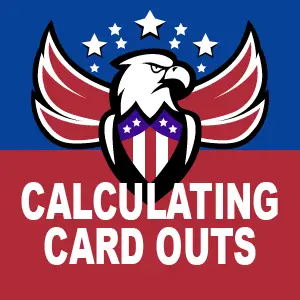Calculating Card Outs

When playing poker, deciding whether to call or fold when facing a bet is necessary. One way to make this decision is by comparing the pot odds and the odds of getting the needed cards (“outs”). It’s crucial to calculate favorable pot odds for a long-term winning strategy. In essence, only make bets with long-term benefits.
How to calculate card outs?
To calculate pot odds, knowing the amount of money in the pot is crucial. In a limit game, count the bets. For example, $100 in a 10 / 20 game on the flop means 10 bets. Divide the amount needed to call by the pot size for online games. If you must call a single bet to remain in the hand, then the pot odds are 10:1.
Preceding steps to calculate outs
The preceding steps are a quick method for determining outs on the next card. Other methods exist.
- Divide the number of cards unseen by the number of “outs” that you have. “Outs” are the cards remaining in the deck that will allow you to make a winning hand.
- Subtract 1.
- There must be at least that many bets in the pot (i.e., multiples of your bet) for a call.
Example calculation
Say you have 2 hearts, and two more hearts fall on the flop. There are now 47 unseen cards. The next card has 9 outs, meaning that out of the 13 unseen hearts, 9 can make a flush.
- Divide 47 by 9 = 5.2
- Subtract 1 = 4.2
There must be at least 4.2 bets in the pot for you to call a single bet. Failing to get the card you need on the turn means possibly repeating the process in the next betting round. Remember that post-turn bets are usually larger than pre-turn bets.
| Hand | Goal | Outs |
|---|---|---|
| Pair | Set (Three of a kind) | 2 |
| Two Pair | Full house | 4 |
| Inside Straight | Straight | 4 |
| Open-Ended Straight | Straight | 8 |
| Four Flush | Flush | 9 |
| Open-Ended Straight-Flush Draw | Straight, Flush, or Straight-Flush | 15 |
Odds and outs
Some people advocate determining the number of outs required to make your hand using all future cards. Needing one card for a flush actually means you have two draws to that card, not one. Doing the math, you get 1.5:1 odds, so 1.5 bets would be your break even. If there is more betting, the next round can force players out.
To calculate pot odds, you need to estimate all future bets to the last card (yours and theirs). This ratio needs to be 1.5 or more, which requires memorizing an “out” list.
| Outs | Turn & River | River |
|---|---|---|
| 20 | 67% / 0.48:1 | 43% / 1.3:1 |
| 19 | 65% / 0.54:1 | 41% / 1.4:1 |
| 18 | 62% / 0.60:1 | 39% / 1.6:1 |
| 17 | 60% / 0.67:1 | 37% / 1.7:1 |
| 16 | 57% / 0.75:1 | 35% / 1.9.1 |
| 15 | 54% / 0.85:1 | 33% / 2.1:1 |
| 14 | 51% / 0.95:1 | 30% / 2.3:1 |
| 13 | 48% / 1.0:1 | 28% / 2.5:1 |
| 12 | 45% / 1.2:1 | 26% / 2.8:1 |
| 11 | 41% / 1.4:1 | 24% / 3.2:1 |
| 10 | 38% / 1.6:1 | 22% / 3.6:1 |
| 9 | 35% / 1.9:1 | 20% / 4.1:1 |
| 8 | 31% / 2.2:1 | 17% / 4.8:1 |
| 7 | 28% / 2.6:1 | 15% / 5.6:1 |
| 6 | 24% / 3:1 | 13% / 6.7:1 |
| 5 | 20% / 4:1 | 11% / 8.2:1 |
| 4 | 16% / 5:1 | 9% / 11:1 |
| 3 | 12% / 7:1 | 6% / 14:1 |
| 2 | 8% / 11:1 | 4% / 22:1 |
| 1 | 3% / 22:1 | 2% / 45:1 |
note on outs to a “winning hand”
Note that it mentions outs to a “winning hand.” There is no automatic system to determine what a “winning hand” is. Maybe that 3-of-a-kind could win. But perhaps there’s 3 cards to a flush on the table. Experience will dictate what you consider a minimum strength hand to win.
The following table displays the outs needed versus the odds:
| 1 | 2 | 3 | 4 | 5 | 6 | 7 | 8 | 9 | 12 | 15 |
| 45 | 22 | 14 | 10 | 8 | 7 | 6 | 5 | 4 | 3 | 2 |
Formula for calculating hand odds in poker
(cards left – outs) / outs (which is the same as cards left / outs – 1)
- E.g.: (47-9) / 9 = 47 / 9 – 1 = 38 / 9 = 4.22 / 1